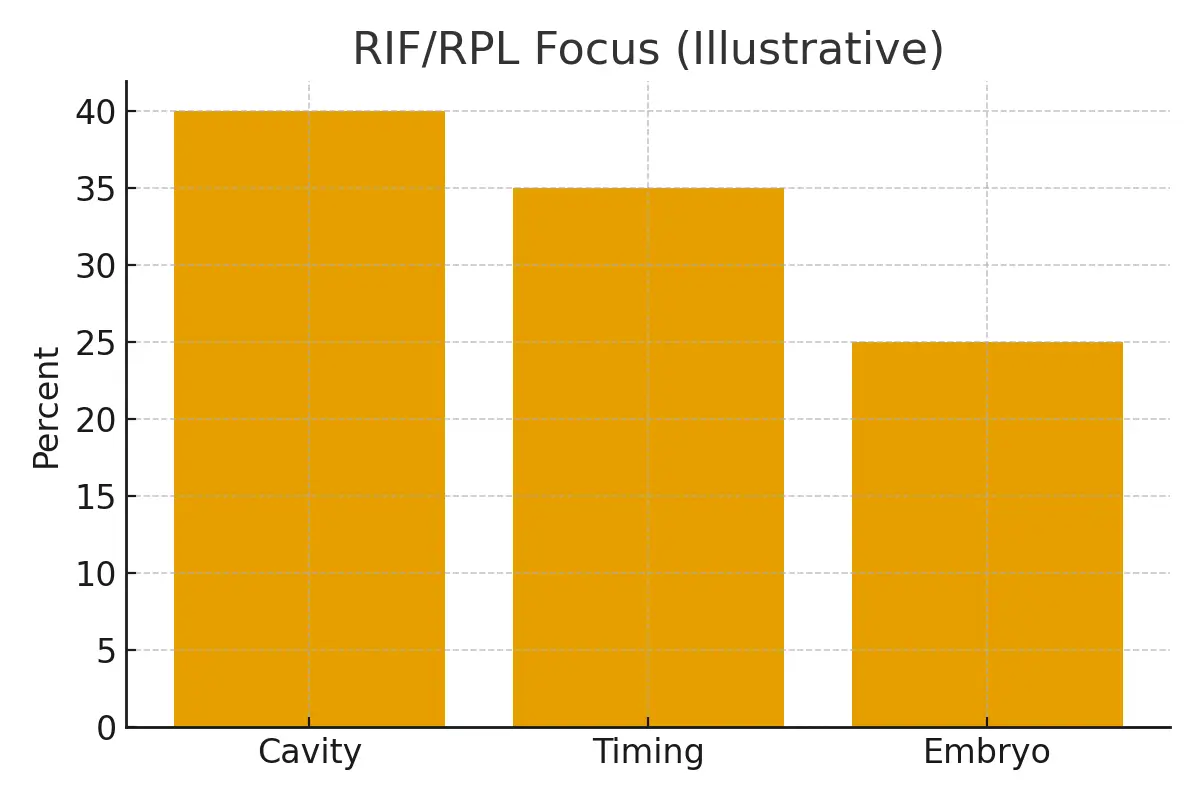
This article explains endometrial receptivity and frozen embryo transfer (FET) protocols within the Uterine & Implantation (RIF/RPL) pathway. It focuses on choices that meaningfully impact outcomes, budgets, and timelines—helping you move forward with confidence.
What It Is
Endometrial receptivity refers to the uterus’s readiness to receive an embryo. FET protocols are structured treatment plans that prepare the uterus for a frozen embryo transfer. Together, they help:
- Align hormone levels with embryo development.
- Optimize implantation chances.
- Reduce wasted cycles and improve predictability.
Who It Helps
Patients who may benefit include those who:
- Have experienced recurrent implantation failure (RIF) or recurrent pregnancy loss (RPL).
- Show inconsistent endometrial thickness or response in previous cycles.
- Require timing adjustments for embryo transfers.
- Want a data-driven, low-risk transfer plan.
Step‑by‑Step Overview
- Cycle evaluation: Review labs, imaging, and previous outcomes.
- Medication protocol: Estrogen and progesterone tailored to uterine response.
- Monitoring: Ultrasounds and blood tests track lining development and hormone levels.
- Adjustments: Timing or medication dosages modified based on response.
- Transfer planning: Finalize FET schedule using mock cycle insights if needed.
Pros & Cons
Pros:
- Confirms uterine readiness before embryo transfer.
- Reduces risk of failed implantation.
- Supports individualized planning for complex cases.
Cons:
- Adds extra monitoring and appointments.
- Can slightly lengthen treatment timelines.
- Additional costs may apply, depending on insurance coverage.
Costs & Logistics
- Line items: Medications, monitoring, lab tests, clinic visits.
- Insurance: Coverage varies; confirm with your provider.
- Planning: Coordinate pharmacy, clinic calendar, and travel to prevent delays.
What Improves Outcomes
- Personalizing protocol based on hormone levels and endometrial response.
- Synchronizing transfer timing with peak receptivity.
- Coordinating logistics to prevent missed appointments or delays.
- Applying evidence-based thresholds for lining thickness and hormone levels.
Case Study
A 36-year-old with prior failed transfers underwent a tailored FET protocol. Adjustments to estrogen timing and luteal support based on endometrial monitoring led to a successful implantation on the subsequent cycle.
Mistakes to Avoid
- Using a one-size-fits-all protocol.
- Ignoring hormone and lining monitoring.
- Delaying adjustments until after failed transfer.
- Overlooking insurance, pharmacy, or travel coordination.
FAQs
Q. How do FET protocols differ from fresh IVF cycles?
Ans : FET protocols prepare a frozen embryo for transfer, allowing greater control of uterine timing without stimulating the ovaries.
Q. What is endometrial receptivity testing (ERA)?
Ans : ERA identifies the optimal window for implantation, helping to time FET for maximum success, especially in patients with prior failures.
Q. How long does a typical FET cycle take?
Ans : Most FET cycles last 3–5 weeks, depending on uterine response and monitoring needs.
Q. Are FET protocols suitable for all patients?
Ans : Not always. They are most beneficial for patients with RIF, RPL, or inconsistent lining development. First-time IVF patients with normal responses may not need complex adjustments.
Q. Will insurance cover FET monitoring and medications?
Ans : Coverage varies by plan. Patients should verify with both their clinic and insurance provider to understand what is included.
Next Steps
- Free 15-min nurse consult
- Upload labs for review
- Personalized cost breakdown for your cycle
Related Links

Dr. Kulsoom Baloch
Dr. Kulsoom Baloch is a dedicated donor coordinator at Egg Donors, leveraging her extensive background in medicine and public health. She holds an MBBS from Ziauddin University, Pakistan, and an MPH from Hofstra University, New York. With three years of clinical experience at prominent hospitals in Karachi, Pakistan, Dr. Baloch has honed her skills in patient care and medical research.





